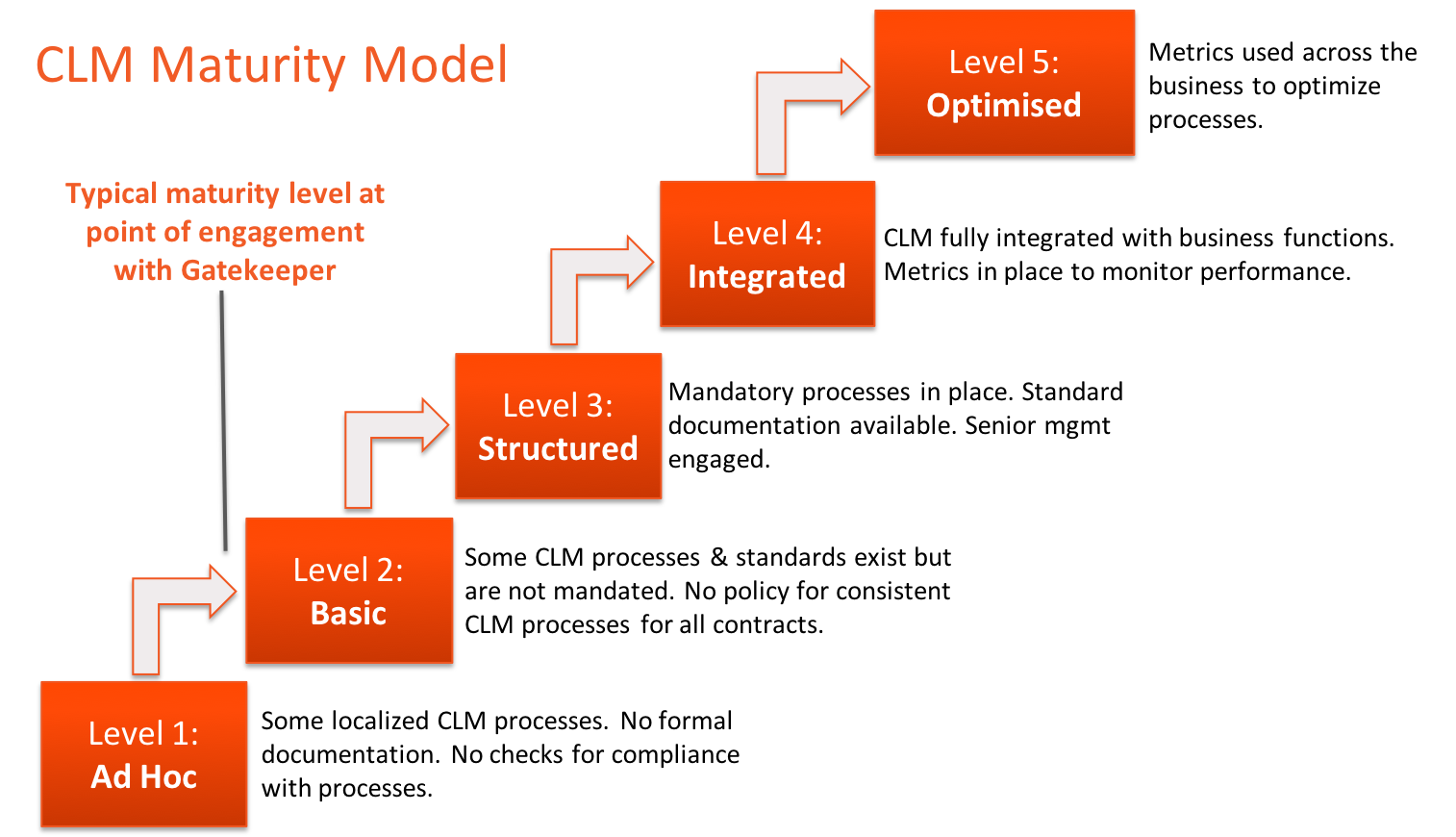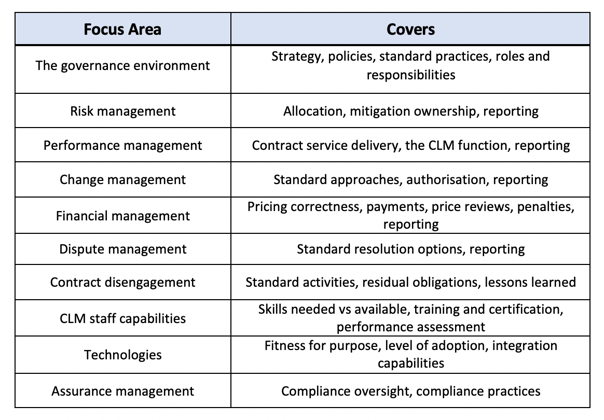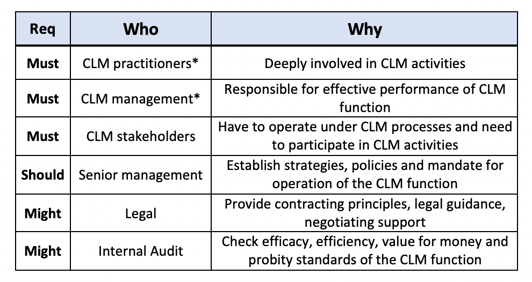In an earlier blog article we discussed the notion of the Capability Maturity Model and applied it to Contract Lifecycle Management (CLM).
The purpose is to identify which of the five maturity levels best describes your business’s current situation. The five maturity levels that are used are as follows:

A lower maturity level means a lower capability, which represents a higher latent risk.
In this article we focus on an approach you can use to determine the maturity level of the CLM function in your organisation, and set you on your way to improving it.
What is a CLM maturity assessment and why is it needed?
The CLM Maturity Model provides a basis for understanding an organisation’s level of capability or maturity of its CLM function and practices.
The CLM maturity assessment delivers several useful outcomes:
- The collection of all point-in-time information needed for the assessment
- The maturity level of each focus area assessed
- The overall maturity level of the organisation
- The major issues requiring attention
- The level of progress achieved since the last assessment, when applicable
- The reasons for any lack of progress between assessments, when applicable
- A draft improvement plan addressing the more concerning issues
- A new organisational maturity level target if applicable.
The key value to be obtained from running regular CLM maturity assessments is clarity about the level of contract risk which is not being effectively addressed in the business. This is risk that may not necessarily be otherwise apparent.
For the purpose of this article, the focus is on CLM from a buyer's perspective.
What does the assessment cover?
Historically the CLM Maturity Model has treated CLM, in the form of contract administration and contract close-out activities, as components of the larger Procurement process, along with procurement planning, solicitation planning, solicitation and source selection.
Today however, CLM is a large enough practice in its own right that the more clearly Procurement aspects can be ignored for CLM maturity assessment purposes.
This approach allows CLM activities like the following to be assessed, regardless of where in the larger Procurement process they may be performed:
- Ensuring the procurement specification covers aspects needed for later management of the contract
- Reviewing the supplier's contract, or the supplier's changes to the organisation's contract, to check that it allows for management of the contract
- Checking that the final contract matches the agreed deal
- Highlighting for the contract approvers’ benefit any matters that need to be resolved following execution of the contract
- Identifying the nature of changes to the organisation's preferred position on certain contract clauses for follow-up analysis
- Developing the contract management plan needed once the contract goes into operation
- Defining contract lifecycle management metrics
- Preparing the contract summary for stakeholders
- Lodging contract documents in the required repositories
While the practices and processes of CLM are the principal target of the maturity assessment, there are many other elements to be considered which influence a business’s ability to operate optimally in relation to its contracts.
All the elements to be treated during the assessment are grouped into the following focus areas:

How is the assessment conducted?
The assessment is conducted by means of a survey. We've created a dedicated survey template which can be downloaded and used as-is, or it can be modified to suit specific needs.
The survey is divided into the ten focus areas listed above, addressing important aspects of CLM both directly and indirectly. Each focus area contains a group of best-case scenarios that would ideally be the case.
This approach allows maturity to be determined by the strength of the divergence that exists in reality as compared to each idealised case.
A good deal of information is required to allow completion of the survey. Some of this information may be contained in official documents like strategy papers, policies and guidelines.
Other information may be obtained anecdotally or by observation, or it may be experienced as part of the general working environment in daily life.
A quick study of the survey contents provides the best guide to the nature of information needed to be able to express a response to each survey statement.
Much of the desired information may be available from an earlier maturity assessment and require only a simple refresh, or the search may have to start from scratch.
Whatever the case, the amount of effort needed to find the required information, and the success rate in finding it, will provide a fair guide to the ultimate outcome of the assessment in terms of derivation of a maturity level.
Whether the survey is to be completed as a group effort or by individuals, a good amount of wide-ranging discussion is likely to be needed. People see things in different ways, depending on their background, experience, level of involvement and general world-view.
A general consensus of the degree of fit with each survey statement will be best obtained through discussion.
This discussion approach will also highlight just what issues are driving certain outcomes, and what the consequences might be of failure to address such issues.
All these step drive the ultimate output of the process, namely the Improvement Plan.
Who can participate in the assessment survey?
It’s reasonable to expect that the key people who need to be involved in the CLM maturity assessment should be those most closely involved with the practice of CLM.
While this should certainly be the case, even in the most immature organisations there will be many other people who can influence or be influenced by CLM practices.
Not all of these people might need to be involved directly in the assessment but could simply be approached to provide the rationale for why certain things are done the way they currently are, for example.
In selecting the wider range of participants for the assessment, common sense should prevail. Not everybody will have the time to get involved so consider carefully whose feedback will be required.
The key to engagement is to keep things short, sharp and fuss-free, backed up by plenty of notice, flexibility and appreciation for whatever input can be obtained.
The ideal list of assessment participants includes:

*For businesses without a dedicated CLM team, these practitioners and managers may simply be the legal team, or any other department with responsibilities for day-to-day contract management.
What activities does the assessment involve?
The detailed activities involved in the assessment are:
- Prepare a plan for the assessment, covering:
- Definition of the required activities and estimated durations
- Identification of participants and roles
- Allocation of tasks to individuals
- Scheduling of sequential and parallel tasks
- Approval of participant involvement, the plan and the timetable
- Review and update as required the maturity assessment survey template to reflect all organisational matters that need to be assessed. This review will also reveal the nature of information that needs to be available for the assessment to be undertaken
- Collect or prepare all information needed to conduct the assessment, which might include items like:
- The organisation's latest strategy position concerning CLM
- The latest organisational policies covering CLM
- Details of the structure, funding and staffing of the CLM function
- All details of any recent CLM maturity assessments
- Any CLM-related statistics that are currently gathered
- An overview of every CLM process currently in place
- An overview of all technologies currently used to assist with CLM activities
- The current contract risk register and risk management approach
- The current contract changes log
- The current skills inventory and training history of all CLM staff
- The latest CLM process performance stats
- A view of senior management and stakeholder satisfaction with the CLM function
- Current stats on the % of contracts tested for obligations compliance in last 12 months plus test outcomes
- Current stats on key contracts' SLA performance over last 12 months
- Provide a score for every survey element and add commentary about issues
- Total the survey scores for each element in every focus area. When there are multiple assessors, average the scores to produce a consolidated score
- Derive a focus area maturity level based on score size using the sum of the individual focus area elements scores
- Total the focus area scores to derive the organisational maturity level
- Analyse the survey commentary to determine the key issues requiring attention
- If this is not the organisation’s first CLM maturity assessment, check how this assessment compares against the last assessment. If there hasn’t been much improvement between the outcomes of the two assessments, determine the reasons, taking into account the original timeframe for achieving such improvement
- Prepare a draft plan for the next period’s improvement roadmap, either as an adjustment of the current plan or as a new plan if a maturity level increase has just been achieved
- Prepare a presentation for senior management for discussion about the issues, the draft plan, and the matters that need their specific attention
- Prepare the final improvement plan based on senior management feedback
How is the assessment scored?
- Assessors need to consider the information collected then indicate the actual reality of each such scenario in their organisation, using the score range specified below
- There’s no hard and fast rule governing just how the assessment should be carried out. Every organisation is different, with different approaches, resources and time. All participants may work together in a single session, either face-to-face or electronically, to complete the survey; multiple independent scorers may operate in isolation, requiring a score consolidation and averaging process to reach a conclusion; or something completely different may happen
- The score range used provides a general indication of the occurrence likelihood of a scenario listed in the survey, namely:

- To the greatest extent possible, the reasoning behind any scores less than four should be recorded in the survey, along with some indication of the issues that might arise from a continued low score. This will not only assist in later analysis of an assessment’s results, but will also provide guidance and understanding to assessors undertaking future assessments
- The CLM maturity level for each focus area is based on the actual score (or averaged score when there are multiple assessors) assigned as a proportion of the maximum score possible for that focus area. The overall CLM maturity level for the organisation is based on the total score assigned across all focus areas as a proportion of the maximum score possible across the entire survey. The maturity level score thresholds are:

What does the assessment reveal?
An assessment will always reveal the issues which have implications for maturity levels. An analysis stage is required to determine:
- What the key issues are
- Which issues have the most serious implications
- Which issues might have the best chance of being relatively quickly addressed
- Which issues are critical for achieving an improvement in the CLM maturity level
If an assessment had been conducted previously, further analysis is required to determine:
- If the organisation’s CLM maturity level in focus areas and overall has improved since the previous assessment, bearing mind the timeframe previously established to achieve improvement
- The extent of any new issues revealed by the current assessment
- The issues where no real progress has been made against the improvement plan prepared from the last survey, and the reasons why
What needs to be addressed in the improvement plan?
A new target maturity level can be established if the assessment shows achievement of the original target, otherwise progress towards the original target should continue.
The combination of the assessment and its analysis contains a large amount of details about the current CLM situation, covering policies, processes, procedures, practices and performance.
These details can now be used to develop a roadmap for improvement initiatives that will produce the biggest payback in terms of minimising risk and maximising efficiency.
That same roadmap should be sufficient to advance the overall maturity to the next level if all issues are successfully dealt with.
Summary
There should always be payback from efforts made to improve the efficiency and effectiveness of an organisation’s processes.
A structured approach to determining where any inefficiencies exist, how serious a risk they represent, and how to go about improving things is much more likely to deliver the required payback.
In this article we’ve described such a structured approach, the maturity assessment, how it can be applied to the Contract Lifecycle Management function and its processes, and how the use of a single number can meaningfully represent the existing state of play.
The contribution that a CLM system has to offer in terms of risk mitigation is getting more recognition and the use of maturity assessments is a powerful tool for discovering and helping to ameliorate contract-related risk.
If you would like more information on how to improve your CLM maturity levels and how to embed the right disciplines and contract management tools in your business then contact Gatekeeper today for a free consultation.


.png)
.png)
.png)
-4.png)